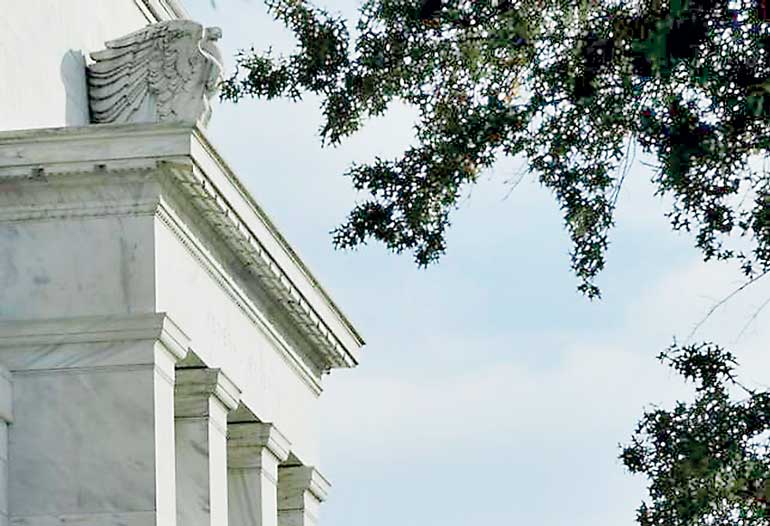Thursday Jan 08, 2026
Thursday Jan 08, 2026
Friday, 31 July 2015 00:00 - - {{hitsCtrl.values.hits}}
 The United States Federal Reserve Board building is shown in Washington - REUTERS
The United States Federal Reserve Board building is shown in Washington - REUTERS
The US economy and job market continue to strengthen, the Federal Reserve said on Wednesday, leaving the door open for a possible interest rate hike when central bank policymakers next meet in September.
Following their latest two-day policy meeting, Fed officials said they felt the economy had overcome a first-quarter slowdown and was “expanding moderately” despite a downturn in the energy sector and headwinds from overseas.
They nodded in particular to the “solid job gains” seen in recent months.
“On balance, a range of labour market indicators suggest that underutilisation of labour resources has diminished since early this year,” the Fed said in a policy statement that kept rates unchanged.
That language and other small changes in the statement mark an upgrade in the central bank’s view of labour conditions since its last policy meeting in June, when it said labour slack had “diminished somewhat.”
The Fed also said it now only needs to see “some” more improvement in the labour market, a qualification that analysts said strongly suggested it believes the recent solid US job gains will continue.
“They slightly lowered the hurdle for a rate hike by adding the word ‘some’ to their conditions required for further improvement in the labour market,” said Shyam Rajan, head of US interest rate strategy at Bank of America Merrill Lynch.
Although the Fed may have ramped up expectations of a rate hike in September, it didn’t give a clear signal of its plans. Besides the additional improvement on the labour front, it said it also needed to be more confident that low inflation will rise to the 2% medium-term target.
U.S. Treasury prices were largely unchanged after the Fed statement. US stocks rose and the dollar was stronger against a basket of currencies.
The Fed’s policy statement also retained language saying that risks are “nearly balanced,” suggesting it is still more concerned about a new economic downturn rather than of rapidly rising inflation.
Central bank officials and market analysts have been waiting to see if weak economic growth in the first part of the year signalled the beginning of the end of an expansion, or merely a pause.
The verdict now seems firm.
“The Fed is taking baby steps towards a rate hike. Enough improvements have been made in the labour market that the Fed only needs a little more confirming evidence to say it is time,” said Brian Jacobsen, chief portfolio strategist at Wells Fargo Funds Management.
Most economists forecast that US economic growth will pick up after a lacklustre first half and that the Fed will begin tightening monetary policy in September, according to a Reuters poll published last week.
And Wall Street’s top banks still target September as the most likely time for an initial Fed rate hike, according to another Reuters poll published earlier this month.
With no meeting scheduled in August, the Fed will have two months of data to analyse before deciding whether to hike rates for the first time since 2006.
There were no dissents in the Fed statement on Wednesday.
 A customer shops at the Wal-Mart Neighborhood Market in Bentonville, Arkansas June 4, 2015. Wal-Mart will hold its annual meeting - REUTERS
A customer shops at the Wal-Mart Neighborhood Market in Bentonville, Arkansas June 4, 2015. Wal-Mart will hold its annual meeting - REUTERS
Washington (Reuters): US economic growth accelerated in the second quarter as solid consumer spending offset the drag from weak business spending on equipment, suggesting a steady momentum that could bring the Federal Reserve closer to hiking interest rates this year.
Gross domestic product expanded at a 2.3% annual rate, the Commerce Department said on Thursday. First-quarter GDP, previously reported to have shrunk at a 0.2% pace, was revised up to show it rising at a 0.6% rate.
The revision to first-quarter growth reflected steps taken by the Government to refine the seasonal adjustment for some components of GDP, which economists said left residual seasonality in the data, as well as new source data.
The Fed on Wednesday described the economy as expanding “moderately” while upgrading its view of the labor market and saying housing had shown “additional” improvement. The Fed’s assessment left the door open for a possible hike in interest rates in September, which would be the first rise since 2006.
A separate report showed first-time applications for state unemployment benefits increased 12,000 last week to a seasonally adjusted 267,000. However, claims remained not too far from their cycle lows.
The dollar extended gains against a basket of currencies, while prices for US Treasury debt fell slightly.
Though second-quarter GDP growth was a bit below economists’ expectations for a 2.6% rate, the growth composition pointed to firming domestic fundamentals.
A measure of private domestic demand, which excludes trade, inventories and government expenditures, increased at a 2.5% rate after rising at a 2.0% pace at the start of the year.
Growth in the second quarter was boosted by consumer spending as households used some of the windfall from cheaper gasoline in late 2014 and early this year to go shopping. The strengthening labor market also encouraged consumers to loosen their purse strings.
Consumer spending, which accounts for more than two-thirds of US economic activity, grew at a 2.9% rate from a downwardly revised 1.8% pace in the first quarter. Consumer spending was previously reported to have increased at a 2.1% rate at the start of the year.